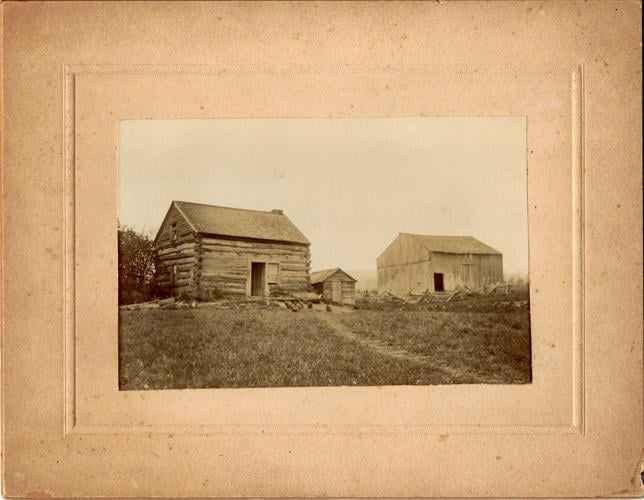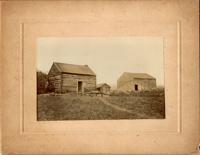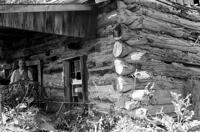Many Americans have grown up reading the “Little House on the Prairie” books, and have a sense of wistfulness about the warm and cozy log cabin of days past.
Many of us also associate log cabins with pioneers to the Western territories, who traveled there in covered wagons, much like the Ingalls family. However, by the time they set up their little house in the 1870s, log cabins were an ancient form of architecture used by different groups all over America. It may surprise some to learn that log cabins were the first and most common form of housing used by non-native settlers to Yates County. Log cabins were just as common dotting our lakeshores and gullies as they were on the prairies.
First brought to the American colonies by Scandinavian immigrants to New Jersey and eastern Pennsylvania in the 17th century, the log cabin became a favorite with other immigrant groups, such as the Ulster Scots and Germans in the Middle Atlantic region. They were so popular because they were quick, easy and cheap to build. The heavily forested countryside provided easy access to logs, and if a family decided to move on, they could easily build another. Only the English, many of whom were already in frame-style or brick houses in New England and Virginia before the log cabin caught on, largely resisted this style of home.
This didn’t stop people of English descent from choosing log cabins for their new homes as they moved into frontier regions in both the North and South, however. Needing to clear huge forests, they used the logs for their homes, intending to build more permanent ones later. Log cabins dotted western New York, Appalachian hollows and the early Midwestern states.
The Public Universal Friend and followers built a rustic cabin on Hewitt Road in Torrey when first arriving between 1788 and 1790. Although no longer standing, the little building housed between 15 and 20 followers, before they began branching out and settling their own farms. The Hewitt family themselves also lived in a log cabin nearby. The Friend’s second house, on Sugar Creek, was also of log. Only the third house built for the Friend in 1814 was a large, solid frame house and is still standing.
Others coming in the same period defaulted to log cabins. Log cabins stood on what is now Main Street in Penn Yan. Several early schools, including the Lakemont School in Starkey, were also log cabins. Most were one room, with a packed dirt floor and a loft above for sleeping. Cooking, eating, socializing and work all took place in the main room, which also served as the parents’ bedroom. Some larger cabins were later divided into rooms, and some in the county broke the traditional mold. An unusual two-story log cabin, complete with rifle slits for defense, once stood near Crosby in Barrington, built in 1806 as the Carr Tavern. John Ingraham, Lettus Potter and Jacob Cartwright all built double log houses — the Ingrahams living in theirs up until 1848, decades after some elegant mansions had been built in the county. Early barns, too, were log constructions.
The norm
According to Miles A. Davis, writing as an elderly man in 1906, log cabins were the norm across Yates County. He lived in one until the age of 12, his mother had taught school in one in 1834, and he grew up surrounded by them. He remembered many from his childhood, most of which were gone by the time of his writing. He pointed out that all but three houses on Guyanoga Road had been log cabins in his youth. It is safe to assume that many Yates County ancestors in the first part of the 19th century spent time living in these simple dwellings. Some were even built communally, in housing “bees,” where neighbors shared the work and then a meal or dance, taking turns when each needed a new cabin. Those coming into the county in the 1830s and ‘40s tended to build more modern houses right away, but those who came in the early days of settlement — and had been living in log cabins — stayed in them later than one would expect.
They were not as comfortable as they seem to us today, viewing them through the lens of nostalgia. Most were one-room structures, cramped with large families. Early ones built in places without a reliable source of stones often had wooden chimneys coated with mud or clay, a fire hazard that caused many to go alight. Dirt floors were impossible to clean; the scent of cooking and wood smoke hung in the air.
Most only had one or two windows on the first floor, so they were dark as well. Glass was prohibitively expensive in this period, so wooden shutters or oiled cloth or paper covered window openings. Otherwise, they stood open to let in air and light, but also allowed in insects. Sometime a Dutch door was utilized to keep children and animals from running in and out. Yards were workspaces and looked unkempt and messy. The walls naturally had spaces between the logs. These cracks were filled with mud mixed with shale, moss or hay, or anything that could block the cold. If this filling failed, cold winter air — and even snow! — blew directly in on the family. Despite these discomforts, the old growth wood used in those early days provided large and strong logs and very sturdy buildings.
These dwellings, while sometimes lived in longer than intended, were never meant to be permanent. By the 1840s, when the Finger Lakes region was coming out of its frontier period, even people in remote areas were influenced by new architectural trends and social conventions. Privacy became more important and rooms with specified uses were looked upon favorably. It began to seem odd to sit in your host’s bedroom on a visit. Changes had to be made. Most log cabin families simply built a new wood-frame, cobblestone, or brick house elsewhere on their property, abandoning the old log home. Sometimes it was utilized for a barn or storage. Over time, they deteriorated and disappeared to the elements. The Carr Tavern and another cabin on Route 14 near Himrod were unusual exceptions that were inhabited well into the 20th century, mostly in their original condition.
Other families chose to economize by upgrading their log cabins. They were added onto with frame additions, and the interior one-room style was divided into specific rooms, such as a dining room and separate kitchen. The lofts were often divided into multiple small bedrooms. Interior walls were plastered and papered, the floors covered in planks and carpets. Interior stairs replaced the loft ladder. Lastly, the outside was covered in frame or shingles. The log cabin, which over time had become a stigma of poverty, was hidden inside a new and more fashionable shell. It is very possible more log cabins exist in Yates County in this form than can be seen.
From days when simple and rustic cabins dotted the hills, streams and glens of Yates County, to today when large mansions line the lakes and even large, modern log cabins can be seen, the housing changes seen in our history are almost unimaginable.





















































